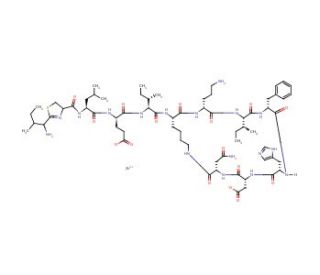

Bacitracin zinc salt (CAS 1405-89-6)
Direktverknüpfungen
Bacitracin-Zinksalz wirkt als Hemmstoff der bakteriellen Zellwandsynthese. Es erreicht dies, indem es die Dephosphorylierung des Lipidträgers stört, der für den Transport von Peptidoglykanvorläufern durch die Zellmembran erforderlich ist. Diese Störung führt letztendlich zur Hemmung der Peptidoglykan-Synthese, was zu einer Schwächung der bakteriellen Zellwände und einer anschließenden Zelllyse führt. Der Wirkmechanismus von Bacitracin-Zinksalz besteht in der Bindung an die Zellmembran und der Störung des Dephosphorylierungsprozesses, wodurch die Synthese von Peptidoglykan unterbrochen wird. Dieser Eingriff auf molekularer Ebene führt letztlich zur Destabilisierung der bakteriellen Zellwände, was für die Untersuchung der bakteriellen Zellwandsynthese und für potenzielle Anwendungen in experimentellen Anwendungen von Nutzen sein kann.
Bacitracin zinc salt (CAS 1405-89-6) Literaturhinweise
- Analyse von Bacitracin durch mizellare elektrokinetische Kapillarchromatographie mit Mischmizellen in saurer Lösung. | Kang, JW., et al. 2001. Electrophoresis. 22: 1356-62. PMID: 11379958
- Regulierung des Bacillus subtilis bcrC Bacitracin-Resistenzgens durch zwei Sigma-Faktoren mit extrazytoplasmatischer Funktion. | Cao, M. and Helmann, JD. 2002. J Bacteriol. 184: 6123-9. PMID: 12399481
- Klonale Stämme von Pseudomonas aeruginosa in pädiatrischen und erwachsenen Mukoviszidose-Einheiten. | O'Carroll, MR., et al. 2004. Eur Respir J. 24: 101-6. PMID: 15293611
- Regulatorische Überlappung und funktionelle Redundanz zwischen den Sigma-Faktoren der extrazytoplasmatischen Funktion von Bacillus subtilis. | Mascher, T., et al. 2007. J Bacteriol. 189: 6919-27. PMID: 17675383
- Biolumineszenz-Bildgebung der hämatopoetischen Stammzellrepopulation in Mausmodellen. | Lin, Y., et al. 2008. Methods Mol Biol. 430: 295-306. PMID: 18370307
- Hyperaktivität des dopaminergen Systems in NTS1- und NTS2-Null-Mäusen. | Liang, Y., et al. 2010. Neuropharmacology. 58: 1199-205. PMID: 20211191
- Tripropeptin C blockiert den Lipidzyklus der Zellwandbiosynthese durch Komplexbildung mit Undecaprenylpyrophosphat. | Hashizume, H., et al. 2011. Antimicrob Agents Chemother. 55: 3821-8. PMID: 21628543
- Die Anhäufung von Heptaprenyldiphosphat sensibilisiert Bacillus subtilis für Bacitracin: Implikationen für den Mechanismus der durch den BceAB-Transporter vermittelten Resistenz. | Kingston, AW., et al. 2014. Mol Microbiol. 93: 37-49. PMID: 24806199
- Darm-Mikrobiota: Firmicutes und Bacteroidetes sind an der Insulinresistenz beteiligt, indem sie den Spiegel von Glucagon-like Peptide 1 vermitteln. | Greenhill, C. 2015. Nat Rev Endocrinol. 11: 254. PMID: 25781856
- Selektiver Nachweis des Antibiotikums Ciprofloxacin durch das fluoreszierende Siderophor Pyoverdin. | Pawar, MK., et al. 2016. Biosens Bioelectron. 81: 274-279. PMID: 26971273
- Antibakterielle Chitosan-Nanofaser-Dünnfilme mit Bacitracin-Zinksalz. | Kumamoto, K., et al. 2021. Polymers (Basel). 13: PMID: 33808445
- Löslichkeit von in Futtermitteln verwendeten Antibiotika in ausgewählten Lösungsmitteln. | Salvatore, MJ. and Katz, SE. 1993. J AOAC Int. 76: 952-6. PMID: 8241823
- Flüssigchromatographische Hochleistungstrennung von Bacitracin Methylendisalicylat | Milenko Sokolic and & Viljem Pavli. 1991 -. Journal of Liquid Chromatography. Volume 14, Issue 10: Pages 1977-1981.
Bestellinformation
| Produkt | Katalog # | EINHEIT | Preis | ANZAHL | Favoriten | |
Bacitracin zinc salt, 1 g | sc-239267 | 1 g | $20.00 |
